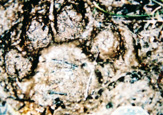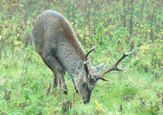





Mande Burong in Meghalaya, India (Page 2 of 2)
The thought of actually taking part in an expedition to hunt for one of crypto zoology’s most enigmatic creatures was too attractive. I had always wanted to do just that. I used to dream of going to British Columbia or Alaska and tracking Sasquatch through the mountainous forests. I had and still do have more interest in the hominid and ape species when it comes down to cryptids than any other. This may be because there is more circumstantial evidence for these species and also because the animals are related to us which sort of makes it easier to relate too and makes it more mysterious as to the origins of our ancestry.
It seems more real. More likely, more feasible that ape man could still be surviving today as we know that they once existed in their many forms. That does not mean that I necessarily believe that the animals seen by modern man on all world continents today or in the near past are descendants of man at all, no they could be something different, not hominids at all, but it would seem more likely that they are, going by the many reports from around the world.
As there have been many hundreds of reports of these animals, and possibly thousands of none reported sightings, then one has to conclude that something exists, hundreds of credible witnesses from all walks of life, and more often than not, naturalists or zoologists, teachers, service men and women, doctors, etc.
It is easy for the sceptic to brush it all aside and say, misidentification, people living in hope, bears, other animals, hoaxes or whatever, but when one actually speaks to one of these miss guided witnesses, on a human man to man level, it seems more likely. That is something that is very lacking in our selfish world these days, proper investigation, involvement, debate, respect for people.
Of the entire strange goings on in the world and debatable subjects, or controversial subjects, it is worth delving and researching. The sceptic is always won over if he or she donates time into actually looking into the subject. Then one will realise that there is more to any story. Every myth, fairy tale, religious writing, or just about anything that seems unbelievable, there is a grain of truth in the matter at least. There are not thousands of people who claim to see Santa clause, or the bogey man, yet we expect our children to believe in it. Scepticism is in my opinion a psychological dysfunction.
It is worth knowing that many of the known species of animals today were once thought to be just tales from idiots and people with over imaginative minds. That is until science eventually seeks them out. Science may not seek out a cryptid, if for example, if it is too deep rooted in mans psyche that it cannot exist. Scientist build barriers and refuse to cross them, from fear of ridicule, loss of a job, peer pressure, or just uncaring selfishness. Topics that are steeped in controversy are ignored. They do not want to waste time or money on a worthless exercise. I may ask the question, why are scientists trying to find out the answers to the universe or the answer to everything, the big bang? Does it really concern our immediate survival? No of course not, so let’s put things into perspective.
We are simply talking about an ape. Why the big deal?
Perhaps it is too near to home. Perhaps it is too obvious, too sensitive. It concerns a possible human relative, a possible evolutionary link from prehistoric ape, to modern man. That is what science is not too keen to delving into for obvious reasons. In the past two hundred years various theory’s have been put forward as to how we evolved from certain ape like ancestors, none of which can be proved, but science is happy to let millions of children and adults alike be conditioned into thinking that it is right. This problem runs through society like a derailed freight train. Many subjects are wrong and as man gains more knowledge of various truths, things will change over the cause of timer, but will it all. How much truth is not told to us? Our we kept in the dark in regard to certain truths or new revelations regarding science?. I believe so. I actually know that we are told a lot of lies in regard to many subjects.
It seems ironic then that large human like apes can be not known to science, yet reports go back hundreds of years! How can this be? So much money and resources are put into researching other species, yet something that could be as important as this is totally ignored. That is human nature. It’s an ass. It must change if we are to get better as a race, but that is perhaps wishful thinking. I could re phrase that to say, it is worth us knowing the truth before we destroy ourselves. The religious fraternity would not allow any truths to get in the way of traditional thinking and teaching especially if it could throw out the whole belief system. Maybe that is one reason as to why no research has been done especially in the USA.
The animal itself may be one basic type. The animals seen all around Northern and central Asia is more likely to be the same, but the animal seen on the large islands maybe something different.
It makes sense to presume that the animal seen around the whole of the Himalayan region and other parts of Eastern Europe or Russia is the same species. It may also be the same as the animal seen in North America and Canada. Just where the Australian animal comes in, I cannot say. The animal is obviously very intelligent, for many reasons. It seems to live in the most remote of areas, away from built up areas of human habitation, the most remote areas on earth.
These areas seem to be pretty devoid of life in the form of vegetation in some cases, which means that the animals would have to travel vast distances not just to find food, and maybe others of their own kind if they are very rare. I do not believe that they live in the high peaks of the Himalaya because there would not be much food for them, even if they are omnivorous in diet, but they will traverse huge distances taking the easier passes over the high mountains with their amazing strength and stamina. This is when I believe that their footprints are found and sometimes seen by people on mountain trecks .A large ape like this would not be made or evolved to live in snow conditions, There are only a few species of primates that can tolerate cold conditions and they have adapted certain life styles to cope with high altitude seasonal winters. A vegetarian large ape would not survive in cold conditions because they would need to eat a lot of greens, as vegetation is not as high in calories, so the animals would not be able to keep warm, especially if they are moving around a lot. The animal must live mainly in warm areas throughout most of the year eating much vegetation and animal life. According to eye witness reports, the animal stalks or runs down bovids, to do that then it must be rather intelligent, similar to a predator like a cat. Animals that stalk need a lot of brain power. The animal must be very witty and know of where to find food and shelter. It must be more intelligent then orang utans, gorillas or even chimps. And to cap it all, the animal seems to be nocturnal. It maybe that man has forced it to be, and that means that it must have been hunted at some time. It is not likely that a nocturnal great ape has evolved to be so. It will not have excellent night vision, but many reports of it having red eyes are confusing if they are to be believed, but maybe the eye shine is reddish like many animals that have moderately good night vision.
People have witnesses the Bigfoot of the Americans swimming very well and this is odd as most apes can not swim at all and only some monkeys do. If this animal can swim well, breast stoke as well as dive under water, then it is more likely to be related to man than any other primate.
It is an oddity that if such an animal existed then why have we not found it, but we must consider that It does live in the most remote parts of the world, and it has been recognized, that is what all the hundreds of reports are. Something mist exist. And I believe that it does.
When the chance came up to investigate and search for the yeti in the north East Indian state of Meghalaya, I was very interested. The area was not known to many westerners, it was not typical yeti country as we know it, yet in a way it seemed more logical that such an animal would live in that area, it seemed as though it was its ancestral home, the warm jungles and evergreen forests. It is just a stones throw away from Bhutan and china and Burma. Reports go back a long way from the Garo people, the native people that settled here from Tibetan, Burmese people hundreds of years ago. The animal would have been more plentiful then, but was plentiful in regard to this kind of animal? We do not know. Maybe family groups of five to ten, maybe they are solitary? There have been sightings of several together. I personally think that the animal would be solitary and females keep young until teen age as most large apes, and family members or other relatives often visit each other, and males would roam large areas, often interacting with there own family groups. I do not think that such a large animal would be communal in the way gorillas are, but more like orang.
The quest to find the large ape man is running out. I do believe that this animal or animals is on the brink of extinction, and it is only for its cunning and intelligent nature that it has survived for so long under mans modern ways. I wonder what the poor creatures think about, when they are searching for members of their own kind.
No person is taking the quest seriously enough, and most crypto zoologists are into the subject from a mysterious point of view, but see it as something not to be found, something always at arms length. The ungraspable truth steeped in mystery. And that is how many people would want it to stay. The serious zoologist or biologist who actually believes in its existence (and they are few and far between) would be sponsored to do a proper search, and then take years to do so. That is what needs to happen.
I would never have expected that sometime in my life, I would be in a stream bed, in a jungle, in Meghalaya looking at the footprints of an animal local people call the Mande burong.
It actually happened.
Page 1 | Page 2 | Page 3 | Photographs